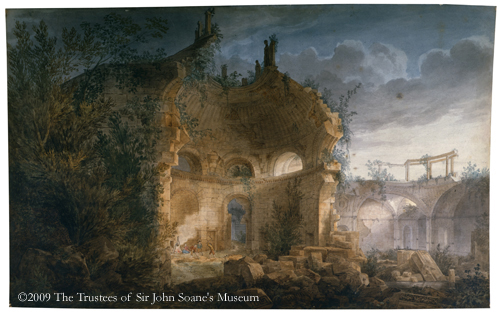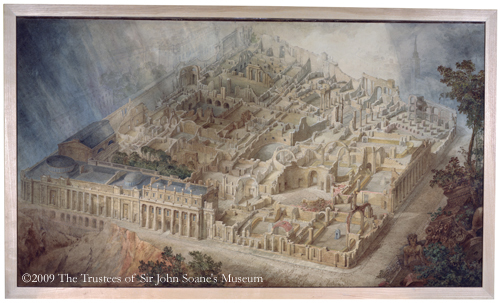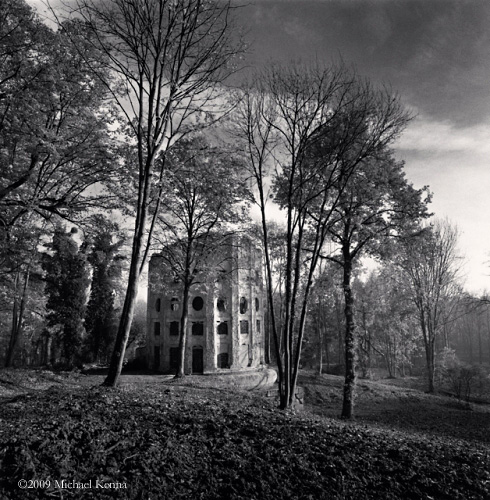The Romantic Ruin
Will Viney
The ruin has a peculiar sense of temporality, one that registers both the termination and the survival of matter. The ruin’s demand for narrative projection and manipulation, what Walter Benjamin calls the “irresistible decay”1 of ruin, emerges in how its fragments seem to have both withstood time and fallen prey to time’s relentless wearing and wasting. The beguiling charm of a ruin arises through our attempts to attend to this untimeliness, to the time of things that have persisted beyond their end. This is one of the central paradoxes that permeates many accounts of Romantic ruin: ruins figure both transience and durability, both the entropic dissolution of all material things and the survival of remainders that seem to outlive this dissolution.
A ruin announces a time that no longer occurs, a time when the building functioned according to human design. The castle no longer defends, the house no longer gives shelter, the sports arena no longer provides a space for gaming or competition, but these purposes and functions remain bound up in the identity of what is left behind. Even in my earliest memories of visiting ruins, I remember the immediate task was to transform toppled stones into spaces of combat, romance, or horror: to give a function to objects that no longer functioned, to give time to a thing that had fallen out of time. With the purposive time of human action and activity at an end, ruins, simply by being labelled a ‘ruin,’ suggest this cinder of a former time, an absent time made present by collapse and decay.
Our impulse to respond to and supplement the lack in the ruin corresponds to that well-worn belief that we all experience ruins subjectively. As Christopher Woodward has argued, it is precisely because each ruin is materially and temporally incomplete that “each spectator is forced to supply the missing pieces from his or her own imagination.”2 Since our perception of a ruin is formed in productive confrontation to these material and temporal absences, we attempt to piece the ruin back together by narrative interpretation. In this way, ruins are always a ruin of something else, they seem to demand a backstory, a ‘life’ that explains the architectural ‘afterlife’ that we encounter. Indeed, there is something about the ruin that seems to demand these sorts of narratives: a projection of what was, what was not, or what yet might be. I would like to argue that this kind of ‘hermeneutic exigency’ is an attempt to stabilise and manage the peculiarly abundant, chaotic, and convolved time of ruin.
John Dyer’s “The Ruins of Rome” (1740) gives a good example of how ruins seem to register transience and endurance, a commingling of past and present, a time in-between. Dyer’s poem follows a “solemn antiquarian” (304) through “Latium’s wide champain, forlorn and waste, / Where yellow Tiber his neglected wave / Mournfully rolls” (11–13). Lonely, silent, disorderly, the poem’s speaker clambers through the ruins of antiquity, affecting a sense of coherence by weaving a complex and self-referential series of narratives. The speaker codes his exploration of classical ruins by tracing a genealogy between Roman ruin and British Empire. Just as Volney would some fifty years later, Dyer utilises the space of ruins to discuss contemporary ethics, politics, commerce, and art. I won’t rehearse the speaker’s moralising arguments in too much detail, but suffice to say he warns his British readers not to go the same way as those decadent Romans: “O Britons, O my countrymen” implores Dyer’s traveller, “beware, / Gird, gird your hearts; the Romans once were free, / Were brave, were virtuous” (511 – 513), but, Dyer seems to argue, they soon fell into bad habits, leaving nothing but their ruins.
If we follow Anne Janowitz’s point that “the national images of both England and … Great Britain are built on [the experience and idea of] Roman ruins,”3 then the relative stability of this building material comes into sharp relief. We return to the paradoxical nature of ruins; whilst ruins might provide Dyer the remnants with which to fashion his nationalist and imperialist ideals, to constitute his present and his future, these remnants are by no means a permanent or reliable fixture of his landscape. Dyer’s Rome is a very dusty place: it is “The throne of nations fall’n; obscur’d in dust” (18). Elsewhere he writes, “So Time ordains, who rolls the things of pride / From dust again to dust. Behold that heap / Of mould’ring urns (their ashes blown away, / Dust of the mighty)” (332 – 335). At every turn the poem reminds us that Rome has fallen and continues to fall into the indistinction of dust, into the turbulent condition that erodes our ability to distinguish between human and architectural remains. Dust figures the disappearance of ruins, the disappearance of Rome. For Dyer, there are few things that can resist this erosion other than narrative itself, his own poetic response to “incessant” (399) and “all-devouring Time” (352): “the modern pile / Perchance may now delight, while that, rever’d / In ancient days, the page alone declares” (165 – 167). Confident of the durability of language, Rome’s ruins require Dyer’s poetic mediation, translation, and interpretation to propel them beyond the entropy of their material conditions. Narrative intervenes here, as it so frequently does in Romantic representations of ruins, to shuttle the ruin forwards and backwards through time. As trace, remnant, and fragment of time, the ruin has the uncanny potential to colonise multiple pasts and futures.
To encounter a ruin is to assume a past, a past that is discontinuous with the present. And yet, what seems remarkable about Romantic representations of the ruin is the effort to project the present into a ruinous future. One of the best-known examples of this is Hubert Robert’s Imaginary View of the Ruins of the Grand Gallery of the Louvre. Painted in 1796, Robert takes a building that had only just become a public gallery and throws it into ruin. As such, the work has often been read as an ambiguous commentary on France’s new and emerging attitude to the public control of artworks. Robert seems to dramatise “the inevitable transience of precisely the institution whose current function is to preserve the artwork from physical [deterioration].”4 Perhaps more telling are the formal techniques Robert uses to represent the work of ruin. See how Robert’s ruins play upon the idea of the frame. We have already mentioned how ruins might act as a framing device for narrative; here Robert discloses how we might manipulate ruins to delimit certain human dramas and perspectives. If Robert intended to offer a frame within a frame and lend a wry comment upon the composition of the picturesque, then he must also be acknowledging the contingent and fragile nature of this framing device, both visually and narratologically. Note, for example, the indeterminacy of the paintings vanishing point. It is “both an infinitely receding wall of the Louvre [and] the emptiness beyond it, as if the gaze were caught in some undecidable tension between containment within the building represented here and [an] escape from that constraint.”5 Our sense of interior and exterior hovers upon an indeterminate zone. As both object and process, ruin appears without discernable boundary or limit. Yet, what the painting achieves spatially it also enacts temporally. Although the painting was completed in 1796, the Apollo Belvedere, seen in the foreground here, came to the Louvre with Napoleon a year later. In this small detail, we see how Robert does not simply give an image of his present as ruin, but a particular, albeit elliptical, history by which the future ruin is contextualised. For Robert, the ruin is an ideal place to stage this temporal drama, with its convergence and complication of pasts, presents, and futures. Despite the painting’s quiet serenity, Robert’s vision of the Louvre shows ruin’s ability to traverse multiple times, to operate through an abundance of tenses.

The English parallel to Robert’s work might be found in Joseph Gandy’s A Vision of Sir John Soane’s Design for the Rotunda of the Bank of England as a Ruin, painted in 1798. Along with more conventional architectural plans, Gandy was commissioned by Soane to project the building into a future state of ruin. Grandeur, monumentality, and the establishment of a genealogical thread between modern and classical design are all at work here; not only must Soane’s bank be designed classically, it must decay classically too. Yet, the relation between antique and modern, past and present, becomes untimely in imaginary view of the bank’s ruins. So in Gandy’s works where the Rotunda is seen intact he places a large clock above the lintel. In this work, however, time has literally been ripped out—our only timepiece is the ruin itself. The companion piece to this painting is what Brian Lukacher has described as a “Piranesian ruinscape.”6

Soane commissioned this work when the building of the bank was nearing its completion in 1830. We may only speculate as to the relationship between these two paintings, yet they were displayed together at the Royal Academy in 1832.7 What we do see is how the genesis of Soane’s bank, its design, construction, and eventual use, is surrounded by images of its dissolution; the imagination of its present was permeated by the state of ruin it would fall into. Again, the idea of the ruin is used to fashion the future and narrate the trajectory of built environments. In reference to these ruin-paintings Daniel Brewer has argued that “the experience of ruins is not an analeptic return to a long-gone past put a proleptic anticipation”8 of the future. But Robert and Gandy show how return and anticipation occur simultaneously; they translate the time of ruin by a discontinuous gesture to both antiquity and modernity. As Byron writes in Don Juan, ruins maintain the power to make us pass across “the equinoctial line / Between the present and past worlds, and hover / Upon their airy confine, half-seas-over.”9 The value of the ruin is precisely this lithe, somewhat drunken sense of temporality, able to represent and lend significance to the present by making the present the past, and, by doing so, make fresh sense of the future. The ruin is not only an object of time but, through narrative manipulation, it can be utilised to reorientate our sense of the now.

The ruins at Désert de Retz were built on the eve of the Revolution, between 1774 and 1789, by François Racine de Monville. They present a far richer, more playful, and temporally complex example of the Romantic obsession with ruins, one closer to Schlegel’s famous observation, “the works of the ancients have become fragments; the works of the moderns are fragments at their inception.”10 With over 17 follies packed within just 35 acres of landscaped garden, Monville juxtaposed the ruins of a gothic church with an Egyptian pyramid, a decaying Greek temple, and a series of rustic altars. Although Diana Ketcham might call the Désert an “architecture of fantasy,”11 it is a fantasy rooted in the figures and forms of architectural history and rehearses in stone what Panini and Piranesi achieved in paint and acid. At the centre of the garden lies what is known as ‘The Broken Column’ an enormous Doric column 55 feet high and 50 feet wide. Inside, a spiral staircase connects 5 floors and approximately 20 rooms making Monville’s column, a ruin that functions, a ruin in which to dwell. The formal, antiquarian response to the column might be to follow the proportions of the Doric order, imaginatively reconstructing the 400-foot temple that the column suggests once existed. Nevertheless, the column demonstrates a demand for time, however gargantuan, fictional or fantastic; it demands time and a narrative explanation of its presence.

“Let us bring to our gardens the changing sets of the opera,” writes Louis de Carmontelle, contemporary of Monville and originator of the term pays d’illusions, “let us see there, in reality, what the most able painters could offer as decoration, all times and all places.”12 As an attempt to synthesize all times and all places, Monville’s pays d’illusions generates and discloses the narrative frames we impose upon objects of ruin. The ruins are allegorical in Walter Benjamin’s sense, generating their allegorical content through what Benjamin called “the highly significant fragment, the remnant.”13 The allegorical provocation rendered by Monville’s follies goes some distance in foregrounding their narraratological, semantic productivity. It is the untimely nature of the ruin, an “untimeliness […] evident in how past, present, and future conspire to converge,”14 that gives the ruin its allegorical force. The Broken Column and the follies that surround it stage a performance of this convergence; not only does the Column suggest a time of use and a past that could never have existed, but it willfully confuses our attempts to divide the time of architecture according to notions of waste and want. Monville’s Column demonstrates the fundamental noncoincidence between the ruin’s outer appearance, the fragmentary distance between past, present, and future, and our narrative attempts to reconcile this noncoincidence. The ruin demands an impossible narrative, an impossible reconciliation between these dispersed and converging times, disrupting our sense of the contemporary and the security of the ‘now.’ The Désert becomes spectral in Jacques Derrida’s sense, prompting the “disjointure in the very presence of the present, this sort of non-contemporaneity of present time with itself.”15 If we make sense of ruins by imposing the temporal frames, the time of use and waste, for example, then Désert de Retz frames those frames and brings their plastic imposition to our attention.
So the time of ruin is a time that generates narrative. We might explain some of the Romantic obsession with ruin by pointing toward ruin’s temporal malleability and intractability, its capacity to symbolise both the transience and endurance of material things. The narrative multiplicity of ruins is a response to and translation of objects that seem, by their very nature, to lie in fragments. We have seen how ruin-narratives do not simply resolve the rents and fissures of the ruin, but, by displaying their narratological tricks and tensions, these narratives can simultaneously display the fragile terms by which we compose and decompose meaning. Indeed, the fabrication and projection of ruin puts the distinction between waste and want under particular scrutiny, disclosing how the time of architecture depends on whether buildings coincide with the projective time of human activity. Whilst the ruin makes and narrates the passing of time, the making of ruins reveals how materiality is always matter both in and of our time.
Endnotes
1. Walter Benjamin. The Origin of German Tragedy 178.
2. Christopher Woodward. In Ruins 15.
3. See Trigg. Aesthetics of Decay 97, and Anne Janowitz, England’s Ruins: Poetic Purpose and National Landscape 20.
4. Daniel Brewer. The Enlightenment Past: Reconstructing Eighteenth-Century French Thought 192.
5. Daniel Brewer, The Enlightenment Past 189.
6. Brian Lukacher, Joseph Gandy. An Architectural Visionary in Georgian England 162.
7. Brian Lukacher, Joseph Gandy 163.
8. Brewer 186.
9. Lord Byron. Don Juan, Canto X 486–488.
10. Friedrich Schlegal, quoted in Marjorie Levinson. The Romantic Fragment Poem: a Critique of a Form 10.
11. Diana Ketcham. Le Désert de Retz: A Late Eighteenth-Century French Folly Garden: The Artful Landscape of Monsieur de Monville 1.
12. Quoted in John D. Bandiera 83.
13. Benjamin 178.
14. Trigg 131.
15. Jacques Derrida. Spectres of Marx: The State of Debt, the Work of Morning, and the new International 25.
Works Cited
Bandiera, John D. “Form and Meaning in Hubert Robert’s Ruin Caprices: Four Paintings of Fictive Ruins for the Château de Méréville.” Art Institute of Chicago Museum Studies 15 (1989): 20–37, 82–85.
Benjamin, Walter. The Origin of German Tragic Drama. London: Verso, 2003.
Brewer, Daniel. The Enlightenment Past: Reconstructing Eighteenth-Century French Thought. Cambridge. CUP, 2008.
Derrida, Jacques. Spectres of Marx: The State of Debt, the Work of Morning, and the new International. Trans Peggy Kamuf. London: Routledge, 1994.
Janowitz, Anne. England’s Ruins: Poetic Purpose and National Landscape. Oxford: Basil Blackwell, 1990.
Ketcham, Diana. Le Désert de Retz: A Late Eighteenth-Century French Folly Garden: The Artful Landscape of Monsieur de Monville. Cambridge, MA: MIT, 1994.
Levinson, Marjorie. The Romantic Fragment Poem: a Critique of a Form. Chapel Hill: U of North Carolina P, 1986.
Lukacher, Brian and Joseph Gandy. An Architectural Visionary in Georgian England. London: Thames and Hudson, 2006.
Trigg, Dylan. The Aesthetics of Decay: Nothingness, Nostalgia, and the Absence of Reason. New York: Peter Lang, 2007.
Woodward, Christopher. In Ruins. London: Chatto & Windus, 2001.

William Viney is completing his doctoral research at the London Consortium. He grew up on a dairy farm in Dorset, England, which may or may not explain his interests in waste, ruin and temporality. A record of this research can be found at: http://narratingwaste.wordpress.com.

0 comments on “Essay: Viney”